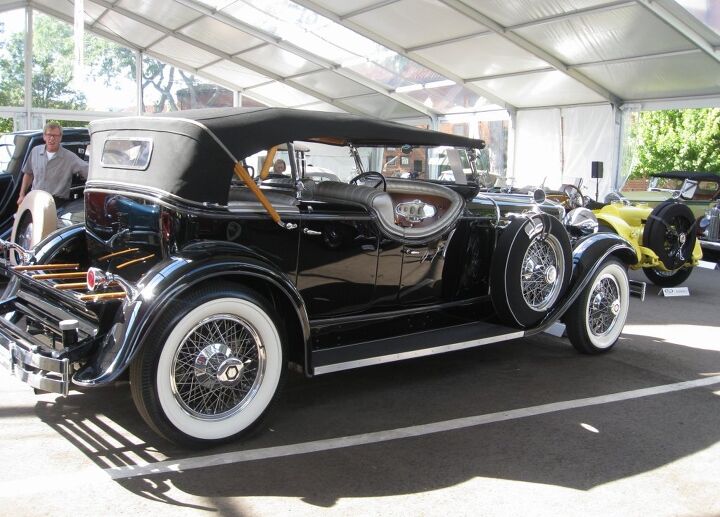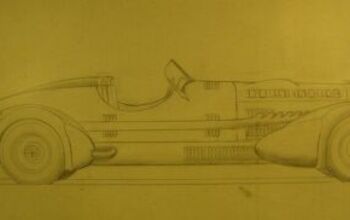Nothing Arrives in Style Like a Dual Cowl Phaeton

1929 Duesenberg Model J by LeBaron
As part of this gig, I see a lot of cars. Besides attending the major corporate auto shows like the North American International Auto Show here in Detroit, from spring into late fall almost every Sunday will find me at some kind of car show. Car museums are also some of my favorite places. Having entered my teens during the 1960s, when there were E Type Jaguars, Corvettes and Mustangs, it was easy for me to dismiss cars from the ’50s as old-fashioned, let alone vehicles from the pre-war classic era. As Mark Twain pointed out, though, I’ve learned a few things since I was a young man and my perspective has changed.
Lincoln Model K
No, I’m still not going to make a tri-five Chevy my daily driver, but I have gained an appreciation for older cars and I’ve decided that if I was wealthy and was looking for car to arrive in, it wouldn’t be a late model Ferrari, Lamborghini or Rolls-Royce. It’d be some kind of dual cowl phaeton from the late 1920s or early 1930s.
1929 Stutz Model M Four-Passenger Speedster by LeBaron
It wouldn’t necessarily have to be a Duesenberg Model J, though its position as the ranking aristocrat of American automobiles makes it the preferred choice. I’m sure that a “senior” Packard, Chrysler Imperial or a V-12 or V-16 Cadillac, would make a similar, if slightly more restrained, statement.
1931 Chrysler CG Imperial Dual-Cowl Phaeton rebodied in the style of LeBaron
It’s not because they’re the most luxurious cars. The dual cowls I’ve seen are no fancier than the coupes and sedans made by the same companies. In fact, there are fewer appointments for the rear passengers than there are in conventional limousines of the same vintage. In a lot of cases the passenger compartments in the back are even a little bit snug — somewhat of a surprise considering just how massive those cars are.
The rear passenger compartment in a dual cowl phaeton can be a little bit cozy as you can see in this Murphy style Duesenberg.
So why do I think dual cowl cars are so fabulous? To begin with, the phaeton roof line is one of the masterpieces of automotive styling. There is a reason why Dean Jeffries made the Monkeemobile a phaeton, beyond the need for seating for all four band members in the back. The long roof (one reason why enthusiasts are attracted to station wagons) and the way it peaks in the back and then slopes towards the front of the car simply looks good.
1935 Duesenberg Model SJ, rebodied in the style of Murphy
Then there’s the dual cowl aspect. Though they are not exactly limousines, they’re functionally equivalent, the owner rides in back, so there is that side of being able to show off your wealth by having a chauffeur. Also, the second cowl gives it the look of a parade car, whether or not the roof is up or down. It’s easy to visualize Queen Elizabeth doing her queenly wave from the back seat.
1930 Packard Deluxe Eight. As impressive as “senior” Packards are, the grille and hood on a Duesenberg J are about a half foot taller.
Will we ever see a modern dual cowl car? I’m not sure that modern car shapes work with the concept, but it would be interesting to see what some of today’s talented car designers could create.
1941 Chrysler Newport, a later take on the dual cowl idiom. Could a modern dual cowl work?
Technically speaking, not all of the cars pictured here are dual cowl phaetons. The Stutz company apparently preferred a different nomenclature, instead calling their dual cowl a “four passenger speedster”, perhaps because of the scalloped, cut-down door.
1928 Stutz BB4 Dual Cowl Touring Car
No matter what you call them, they’re magnificent automobiles.
As the Great Depression wore on, by the late 1930s big open cars were no longer fashionable. Perhaps those who retained their wealth or managed to amass new fortunes did not want to appear to be showing off that wealth or perhaps closed limousines afforded them some level of anonymity at a time when rich folks might have wanted to keep a low profile. Either way, I don’t know of a dual cowl car made since before WWII. The original Chrysler Newport, which was used as a pace car for the 1941 Indy 500, has a second cowl, but it was primarily a concept show car and only six of them were made.
Pierce Arrow 1930 Model B Sport Phaeton. Note the Pierce Arrow’s signature “Dawley” headlights that were faired into the fenders.
With the Monkeemobile, Dean Jeffries was able to successfully apply a phaeton roofline to a 1960s era car. It would be interesting to see what contemporary designers could do applying a phaeton roof and a second cowl to today’s shapes. Do you think it would even be possible to make a modern dual cowl phaeton?
If you had an unlimited budget, which car would you choose to arrive in style?
Photos by the author. You can see the complete galleries and more dual cowl phaetons here.
Ronnie Schreiber edits Cars In Depth, a realistic perspective on cars & car culture and the original 3D car site. If you found this post worthwhile, you can get a parallax view at Cars In Depth. If the 3D thing freaks you out, don’t worry, all the photo and video players in use at the site have mono options. Thanks for reading – RJS

Ronnie Schreiber edits Cars In Depth, the original 3D car site.
More by Ronnie Schreiber
Latest Car Reviews
Read moreLatest Product Reviews
Read moreRecent Comments
- THX1136 It's good knowing a purchase decision was well made. Glad to hear it's been a good car for you, Corey! May the good times continue to roll.
- Kwik_Shift_Pro4X I like bright red, like Ford's "Race Red" with black accents/trim on hot hatches. A distant second would be a lighter school bus yellow, like on a 90s Land Rover Discovery Camel Trophy edition.
- KOKing The color has to look right on the car first and foremost, but given the choice, I'll pick the not-bland color every time.
- Redapple2 Like the color but would never buy. Gladiator? Love them. (but some say they drive super wonky?)
- Redapple2 Note to layman. Lifts change the resting angles of suspension components. Then add full length of travel in the duty cycle and now you are repeatedly doing things to the suspension was never design for. Failures are very common and fatal. Do it only if you are stupid.











































Comments
Join the conversation
Chrysler had a dual cowl concept in the 90s! Oh how I love Chrysler concepts from the mid-90s to mid-00s. I want a Dodge Demon/Copperhead, Chrysler Phaeton, Chrysler Firepower, Jeep Rescue, and Chrysler Chronos! http://www.allpar.com/cars/concepts/1997-phaeton.html
If I hit the Lotto, I'd love to have a Duesenberg. Already got a coffee table book, & a small model. Fabulous cars. Everything done by hand, no computers or CAD/CAM. Powerful engine that dwarfed everything in output until the 1950's. 265-horsepower, 32-valve, DOHC inline-8 that displaced a whopping 420 cubic inches (6.9 liters). The supercharged SJ's (only 32 factory built) supposedly put out 320 hp. I would not be able to pass up a dual cowl phaeton or a Murphy disappearing top. And the special Duesies are spectacular: J-437 Weymann Tapertail (1 of 1) SJ-513 20 Grand by Rollston (1 of 1) SJ-585 by Gurney-Nutting (1 of 1) SJ-397 Rudolf Bauer by Rollson (no S), (1 of 1) SSJ-563 & 567 by Central-LaGrande (2 of 2) The list goes on.